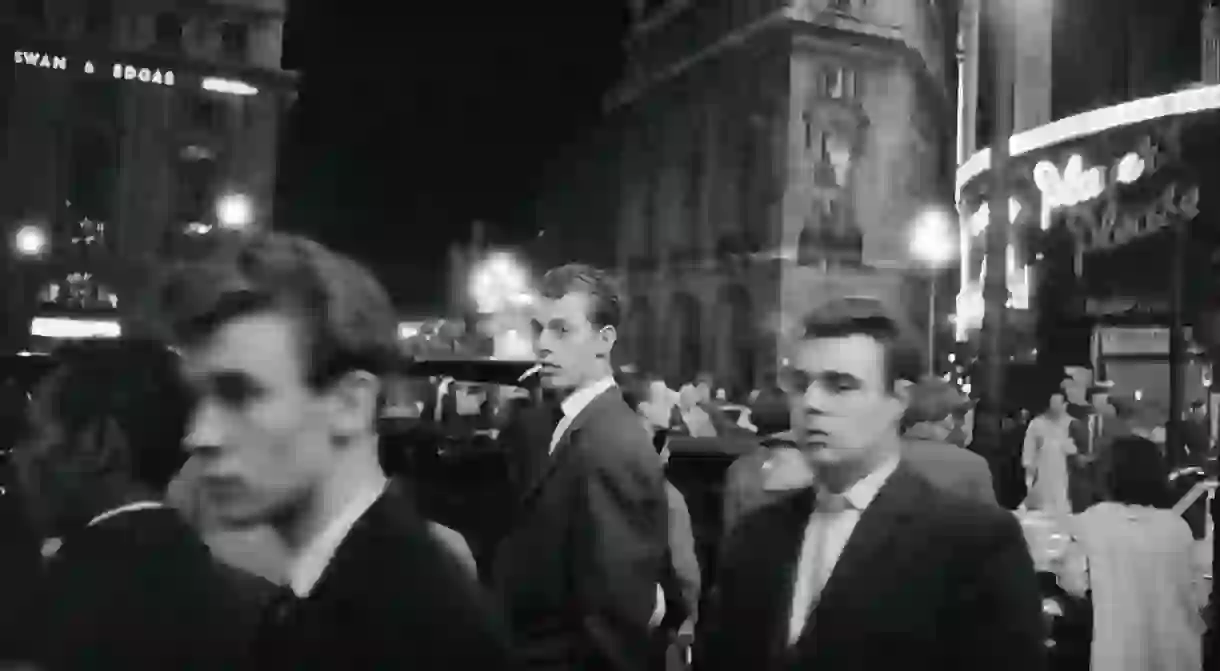Discover the City After Dark in ‘London Nights’ at the Museum of London

The city after dark has long fascinated artists, writers and film-makers. Be prepared to be plunged into the electric as well as dingy depths of the capital with the Museum of London’s photography exhibition, London Nights. From the late 19th century to the present day, over 200 photographs by the likes of Bill Brandt and Nick Turpin illustrate the metropolis after the sun has gone down.
There are many universal myths as to how night and day came about. In Christianity, God deemed light good and separated it from the darkness, creating evening and morning, and day and night. In Japan they believe Amaterasu, the sun goddess, was so ashamed of her brother, the moon god Tsukuyomi’s actions after she sent him to Earth that she vowed never to see him again and, as a result, the moon only reveals its self once the sun has set. While in Egyptian mythology, the moon god Khonsu is charged with guiding people to wherever they are going in the sun god Ra’s absence.
After the First World War, Dada and Surrealist artists turned the notion of night and day on its head. Where daylight had been the epitome of clear thinking, true sight and night was full of terror and nightmares; the new school of thought, championed dreams as being the only moment when you could be truly free. In dreams the subconscious became unshackled unlike the waking mind, which was enslaved by reason and rational thought. Dreamscapes became the playground of the Surrealists, and night-time was never the same again.

From partying the night away and provocative pastimes to contemplative stillness and an eerie loneliness, London’s evening landscape has become the source of inspiration for many photographers.
Wanting to encapsulate all the activity (or inactivity) and psychological connotations that night-time brings, London Nights focuses on the period between dusk and dawn when the city takes on a new character.
‘As the sun sets over London each night the mood changes as people head home, to work or off out on the town,’ says Anna Sparham, curator of photography at the Museum of London.

‘Through powerful photography London Nights will explore everything from the twinkling lights and buzzing nightlife to the darker, more uncomfortable vulnerability that sometimes arises in the urban, or suburban night environment.’
Divided into three sections, the exhibition starts with ‘London Illuminated’ in which photographers ‘gravitate towards the effects and impact of limited natural light and artificial night light’. Sparham asserts in the exhibition’s accompanying book: ‘They are collectively intrigued by and drawn to the way such light plays upon the nightscape and how that can translate through the lens.’

In the 1880s, Electric Avenue in Brixton became the first market street in London to be entirely lit by electric light. Before this technological achievement, photographers embraced the challenge of capturing night scenes that were sparsely lit or periodically punctuated by fluorescent glows. Imagine waiting up to 45 minutes to take a photograph. Paul Martin did just that for many of his images from his London by Gaslight series in 1896. His blue-tinged glass slides manage to evoke the dimly lit London streets with alluring accuracy – or so we can imagine.
Street lighting aids the photographer here to either record Central London’s architectural landmarks without the distraction of figures or to create unnerving filmic moments with ominous allusions. Harold Burdekin’s moody Sinister Street from his London Night series of 1934 evokes a film noir feel. Within the same lineage, William Eckersley’s photographs from his 2011 series Dark City verge on documenting pre-crime or post-apocalyptic scenes.

This unnerving menace night-time can create and endorse is further explored in ‘Dark Matters’. Here, emotion and imagination are the conceptual markers for the photographers, who explore what literal darkness can overshadow a city and what might our fears imagine during the dark hours of the city.
From Bill Brandt’s haunting images of people in London Underground stations seeking refuge from potential death during the Blitz to Tom Hunter’s narrative-driven series Living in Hell and Other Stories (2005), which was realised in response to sensationalist newspaper headlines, the literal and the fabricated darker side of London is captured.

The final section of the exhibition, ‘Switch On…Switch Off…’, shines a light on London’s nocturnal activities of work, rest and play. As a 24-hour city, night is when all manner of pursuits get under way – whether it’s starting shift work, embarking on a night on the tiles or making your way home after a long day.
Nick Turpin’s striking glimpses of passengers on the night bus at Elephant and Castle capture this limbo period of travel with poetic beauty, which is brilliantly counterbalanced by the antics of night-time revellers in Terry Spencer’s club-scene images.

The photographers in London Nights portray a city that comes alive in all manner of ways after sunset: the glamorous cabaret performers, the squalid streets, the frivolities of youth, the slog of industry workers, the harsh realities and the otherworldly existences. They document the unseen, the overlooked and the forgotten in such a way that it will brighten, if at times question, your view of the Big Smoke.

London Nights is at Museum of London, 150 London Wall, London EC2Y 5HN until November 11, 2018. Tickets are £5.50–£12.50.
London Nights by Anna Sparham / Museum of London is published by Hoxton Mini Press in May at £19.95.
Want to see more art in London? Here are the photography exhibitions to see this week.













